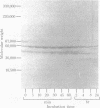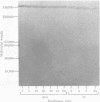Abstract
The human neutrophil peptide-generating protease, which generates a low molecular weight vasoactive peptide from a plasma protein substrate, is directly fibrinolytic and cleaves human fibrinogen in a manner distinct from plasmin. Fibrinogen was reduced from 340,000 Mr to derivatives of 270,000-325,000 Mr during interaction with the protease at enzyme-to-substrate ratios of 0.3 or 1.0 microgram/1.0 mg. The 310,000-325,000 Mr cleavage fragments exhibited prolonged thrombin-induced clotting activity but were able to be coagulated, whereas the 270,000-290,000 Mr fragments were not able to be coagulated. Anticoagulants were not generated at either enzyme dose. As analyzed by sodium dodecyl sulfate/polyacrylamide gel electrophoresis in 4-30% gradient gels and 10% gels stained for protein and carbohydrate, the diminution to 310,000-325,000 Mr and the prolongation of thrombin-induced clotting time resulted from cleavage of the fibrinogen A alpha chain. The further decrease in size to 270,000-290,000 Mr was associated with B beta-chain and gamma-chain cleavage and an inability to form gamma-gamma dimers. The neutral peptide-generating protease, a distinct human neutrophil neutral protease with fibrinolytic and fibrinogenolytic activities comparable to those of plasmin on a weight basis, cleaves fibrinogen in a manner that is distinct from the action of plasmin, leukocyte elastase, and leukocyte granule extracts. It may be that the concerted action of this neutrophil protease to generate a vasoactive peptide and to digest fibrinogen and fibrin facilitates neutrophil movement through vascular and extravascular sites.
Full text
PDF




Images in this article
Selected References
These references are in PubMed. This may not be the complete list of references from this article.
- Barnhart M. I. Importance of neutrophilic leukocytes in the resolution of fibrin. Fed Proc. 1965 Jul-Aug;24(4):846–853. [PubMed] [Google Scholar]
- Bilezikian S. B., Nossel H. L. Unique pattern of fibrinogen cleavage by human leukocyte proteases. Blood. 1977 Jul;50(1):21–28. [PubMed] [Google Scholar]
- Binder B. R., Spragg J., Austen K. F. Purification and characterization of human vascular plasminogen activator derived from blood vessel perfusates. J Biol Chem. 1979 Mar 25;254(6):1998–2003. [PubMed] [Google Scholar]
- Coblyn J. S., Austen K. F., Wintroub B. U. Purification and characterization of a human neutrophil neutral protease. The neutral peptide-generating protease. J Clin Invest. 1979 May;63(5):998–1005. doi: 10.1172/JCI109400. [DOI] [PMC free article] [PubMed] [Google Scholar]
- Deutsch D. G., Mertz E. T. Plasminogen: purification from human plasma by affinity chromatography. Science. 1970 Dec 4;170(3962):1095–1096. doi: 10.1126/science.170.3962.1095. [DOI] [PubMed] [Google Scholar]
- Furlan M., Beck E. A. Plasmic degradation of human fibrinogen. I. Structural characterization of degradation products. Biochim Biophys Acta. 1972 May 18;263(3):631–644. doi: 10.1016/0005-2795(72)90044-x. [DOI] [PubMed] [Google Scholar]
- Gramse M., Bingenheimer C., Schmidt W., Egbring R., Havemann K. Degradation products of fibrinogen by elastase-like neutral protease from human granulocytes. Characterization and effects on blood coagulation in vitro. J Clin Invest. 1978 Apr;61(4):1027–1033. doi: 10.1172/JCI109001. [DOI] [PMC free article] [PubMed] [Google Scholar]
- Granelli-Piperno A., Vassalli J. D., Reich E. Secretion of plasminogen activator by human polymorphonuclear leukocytes. Modulation by glucocorticoids and other effectors. J Exp Med. 1977 Dec 1;146(6):1693–1706. doi: 10.1084/jem.146.6.1693. [DOI] [PMC free article] [PubMed] [Google Scholar]
- Lahiri B., Shainoff J. R. Fate of fibrinopeptides in the reaction between human plasmin and fibrinogen. Biochim Biophys Acta. 1973 Mar 23;303(1):161–170. doi: 10.1016/0005-2795(73)90157-8. [DOI] [PubMed] [Google Scholar]
- Marder V. J., Shulman N. R., Carroll W. R. High molecular weight derivatives of human fibrinogen produced by plasmin. I. Physicochemical and immunological characterization. J Biol Chem. 1969 Apr 25;244(8):2111–2119. [PubMed] [Google Scholar]
- Marder V. J., Shulman N. R. High molecular weight derivatives of human fibrinogen produced by plasmin. II. Mechanism of their anticoagulant activity. J Biol Chem. 1969 Apr 25;244(8):2120–2124. [PubMed] [Google Scholar]
- Ohlsson K., Olsson I. The neutral proteases of human granulocytes. Isolation and partial characterization of two granulocyte collagenases. Eur J Biochem. 1973 Jul 16;36(2):473–481. doi: 10.1111/j.1432-1033.1973.tb02932.x. [DOI] [PubMed] [Google Scholar]
- Pizzo S. V., Schwartz M. L., Hill R. L., McKee P. A. The effect of plasmin on the subunit structure of human fibrinogen. J Biol Chem. 1972 Feb 10;247(3):636–645. [PubMed] [Google Scholar]
- Plow E. F., Edgington T. S. An alternative pathway for fibrinolysis. I. The cleavage of fibrinogen by leukocyte proteases at physiologic pH. J Clin Invest. 1975 Jul;56(1):30–38. doi: 10.1172/JCI108076. [DOI] [PMC free article] [PubMed] [Google Scholar]
- RIDDLE J. M., BARNHART M. I. ULTRASTRUCTURAL STUDY OF FIBRIN DISSOLUTION VIA EMIGRATED POLYMORPHONUCLEAR NEUTROPHILS. Am J Pathol. 1964 Nov;45:805–823. [PMC free article] [PubMed] [Google Scholar]
- Rosenberg R. D., Damus P. S. The purification and mechanism of action of human antithrombin-heparin cofactor. J Biol Chem. 1973 Sep 25;248(18):6490–6505. [PubMed] [Google Scholar]
- Schmidt W., Havemann K. Isolation of elastase-like and chymotrypsin-like neutral proteases from human granulocytes. Hoppe Seylers Z Physiol Chem. 1974 Sep;355(9):1077–1082. doi: 10.1515/bchm2.1974.355.2.1077. [DOI] [PubMed] [Google Scholar]
- Silverstein R. M. The determination of human plasminogen using Nalpha-CBZ-L-lysin p-nitrophenyl ester as substrate. Anal Biochem. 1975 May 12;65(1-2):500–506. doi: 10.1016/0003-2697(75)90535-7. [DOI] [PubMed] [Google Scholar]
- Weber K., Osborn M. The reliability of molecular weight determinations by dodecyl sulfate-polyacrylamide gel electrophoresis. J Biol Chem. 1969 Aug 25;244(16):4406–4412. [PubMed] [Google Scholar]
- Wintroub B. U., Goetzl E. J., Austen K. F. A neutrophil-dependent pathway for the generation of a neutral peptide mediator. II. Subcellular localization of the neutrophil protease. Immunology. 1977 Jul;33(1):41–49. [PMC free article] [PubMed] [Google Scholar]
- Wintroub B. U., Goetzl E. J., Austen K. F. A neutrophil-dependent pathway for the generation of a neutral peptide mediator: partial characterization of components and control by alpha-1-antitrypsin. J Exp Med. 1974 Sep 1;140(3):812–824. doi: 10.1084/jem.140.3.812. [DOI] [PMC free article] [PubMed] [Google Scholar]
- Zacharius R. M., Zell T. E., Morrison J. H., Woodlock J. J. Glycoprotein staining following electrophoresis on acrylamide gels. Anal Biochem. 1969 Jul;30(1):148–152. doi: 10.1016/0003-2697(69)90383-2. [DOI] [PubMed] [Google Scholar]




